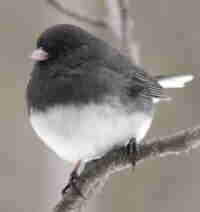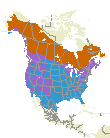 Dark-Eyed Junco Dark-Eyed JuncoJunco
hyemalis
Description
The dark-eyed junco is 5 to 6.5
inches long, with an average wingspan of 9.25
inches. It has dark gray plumage on its head,
breast and upper parts, with striking white
plumage on its outer tail and belly. Females and
immatures are somewhat browner than males.
Distribution and
Habitat
 This species breeds across most of
Canada and winters throughout the United States
into northern Mexico. There are also year-round
populations scattered through the Rocky and
Appalachian mountain systems. It is found from
sea level to timberline in a variety of woodland
areas that have openings with dense herbaceous
ground cover. In winter it prefers weedy fields,
but also inhabits open woodlands, hedgerows,
suburbs, and farmyards. This species breeds across most of
Canada and winters throughout the United States
into northern Mexico. There are also year-round
populations scattered through the Rocky and
Appalachian mountain systems. It is found from
sea level to timberline in a variety of woodland
areas that have openings with dense herbaceous
ground cover. In winter it prefers weedy fields,
but also inhabits open woodlands, hedgerows,
suburbs, and farmyards.
Reproduction
Dark-eyed juncos are
monogamous. Males usually arrive on breeding
grounds well ahead of the females, and pairs are
formed by mid-April. Males claim territories of 2
to 3 acres. When a female enters a male's
territory, the male pursues her aggressively.
Once a pair is formed, males follow their mates
and are seldom more than 50 feet away.
The female builds the nest over a period of 1
to 9 days, but the male usually helps by bringing
nest material. Nests are usually built on the
ground near the edge of openings in wooded areas
or in a slight depression. They are occasionally
built up to 8 feet above ground in a shrub or
tree. 3 to 6 white or pale green eggs spotted
with brown are laid per clutch. Incubation is
done by the female alone for 12 to 13 days.
Chicks leave the nest 9 to 13 days after
hatching, and become independent of their parents
at about 3 weeks of age. Both parents defend the
nest from predators, keep the nest clean, and
feed the chicks. Sexual maturity is reached at
about 1 year of age. Most dark-eyed juncos will
raise 2 or 3 broods per season.
Diet
This species forages on the ground for a wide
variety of seeds and some insects. In the
non-breeding season, it feeds primarily on
insects, non-insect arthropods, and seeds. During
the breeding season, it feeds mostly on insects.
Dark-eyed juncos will visit bird feeders during
migration and in the winter months, but prefers
to feed on the seeds that have fallen to the
ground rather than from the feeders themselves.
Other Habits and Behaviors
Dark-eyed juncos usually hop or walk as they
move along the ground.
This species is social during autumn and
winter months. Winter flocks typically contain 15
to 25 individuals, with the flocks forming in the
morning and dispersing in the evening. Flocks
tend to winter in the same area year after year.
Within winter flocks, males tend to be dominant
over females and adults are dominant over the
younger birds. Females tend to winter farther
south away from the males.
Older males almost always return to their old,
established breeding territories.
Dark-eyed juncos have a variety of songs in
their repertoire. Only males sing.
Scientific
Classification
phylum Chordata
subphylum Vertebrata
class Aves
order Passeriformes
family Emberizidae
genus & species Junco hyemalis

All About Birds www.allaboutbirds.org/guide/Dark-eyed_Junco/id
Animal Diversity Web http://animaldiversity.org/accounts/Junco_hyemalis/
Questions or comments about
this page?
|



